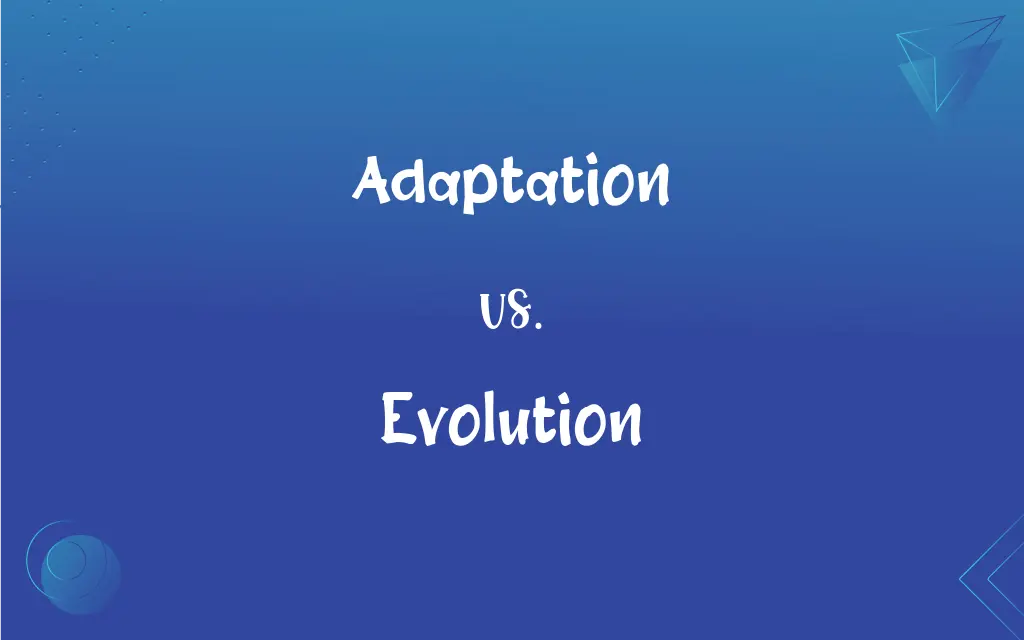Adaptation vs. Evolution: What's the Difference?
Edited by Aimie Carlson || By Janet White || Published on December 23, 2023
Adaptation refers to changes in organisms to better suit their environment, while evolution is the gradual change in species over generations through natural selection and genetic variations.

Key Differences
Adaptation is a process where an organism becomes better suited to its habitat; this can involve physiological, behavioral, or structural changes. Evolution, however, is a broader process that encompasses the genetic change in populations over generations, leading to the development of new species.
An adaptation can be a specific trait, like the thick fur of polar bears for cold climates. Evolution is the cumulative effect of these adaptations over long periods, resulting in significant changes in the species, such as the development of new species.
Adaptations occur as a response to environmental challenges and can happen relatively quickly. Evolution, on the other hand, is a gradual process, often taking thousands to millions of years, involving numerous adaptations and genetic changes.
While adaptation often refers to a trait or a set of traits improving survival or reproduction, evolution encompasses both the rise of these traits and their spread or disappearance in a population over time.
Adaptation is about immediate survival and success in a given environment, whereas evolution is about long-term changes that occur in a species as a consequence of these adaptations and other genetic variations.
ADVERTISEMENT
Comparison Chart
Definition
Changes in organisms for better environmental suitability
Gradual genetic change in species over generations
Time Frame
Can occur within a few generations
Occurs over many generations, often slowly
Scope
Specific traits or behaviors
Entire species and the emergence of new species
Mechanism
Natural selection, genetic mutations, environmental pressure
Natural selection, genetic drift, mutation, gene flow
Outcome
Improved survival or reproduction in current environment
Long-term species change, biodiversity creation
ADVERTISEMENT
Adaptation and Evolution Definitions
Adaptation
Adaptation is the process by which a species becomes better suited to its environment.
The adaptation of camels to desert conditions includes water conservation and temperature regulation.
Evolution
It involves the gradual development of new species through natural selection.
The evolution of finches on the Galapagos Islands showcased different beak shapes adapting to food sources.
Adaptation
Adaptation involves physiological changes in response to environmental factors.
The adaptation of deep-sea creatures includes developing bioluminescence for communication.
Evolution
Evolution includes both the genetic change in organisms and the resulting biodiversity.
The evolution of mammals after the dinosaur extinction led to a surge in biodiversity.
Adaptation
It can be a short-term acclimatization or a long-term genetic change.
Birds migrating to warmer climates during winter is a seasonal adaptation.
Evolution
Evolution is the process of change in the inherited traits of a population over generations.
The evolution of the horse from small, multi-toed creatures to large, single-toed animals took millions of years.
Adaptation
It can refer to a physical or behavioral characteristic that enhances survival.
The bright colors of poisonous frogs are an adaptation for warding off predators.
Evolution
It is driven by mechanisms like mutation, gene flow, genetic drift, and natural selection.
The evolution of antibiotic resistance in bacteria is an example of natural selection.
Adaptation
Adaptation also encompasses the development of new behaviors or skills.
The adaptation of humans to use tools significantly advanced their survival.
Evolution
Evolution explains the diversity of life and the adaptation of species to their environment.
The diverse evolution of human cultures shows adaptation to various environmental and social conditions.
Adaptation
The act or process of adapting.
Evolution
A gradual process in which something changes into a different and usually more complex or better form.
Adaptation
The state of being adapted.
Evolution
A result of this process; a development
Judo is an evolution of an earlier martial art.
FAQs
Can adaptation lead to evolution?
Yes, adaptations can accumulate over time, leading to evolution.
What are examples of adaptation?
Bird beak shapes, camouflage in animals, and plant thorniness.
Is evolution always a slow process?
Typically, yes, but some changes can occur relatively quickly.
What is a famous example of evolution?
The evolution of Darwin's finches in the Galapagos.
What is evolution?
Evolution is the gradual change in species over generations.
Do individual organisms evolve?
No, evolution occurs in populations over generations.
What is adaptation?
It's the process of becoming better suited to an environment.
How do adaptations benefit organisms?
They improve survival and reproductive success.
How does natural selection relate to evolution?
It's a mechanism by which advantageous traits become more common.
Can humans influence adaptation in other species?
Yes, through actions like habitat changes and selective breeding.
Are all adaptations beneficial?
Most are, but some can be maladaptive in changing environments.
What role do genetics play in evolution?
Genetic variations are fundamental to evolutionary changes.
Is evolution a theory or a fact?
Evolution is a well-supported scientific theory explaining observed facts.
Can evolution revert or reverse?
Evolution doesn't 'reverse', but traits can reappear if beneficial.
How does climate change impact adaptation and evolution?
It creates new environmental pressures that can drive both processes.
What evidence supports evolution?
Fossil records, genetic studies, and observable changes in species.
How do new species evolve?
Through the accumulation of genetic changes that lead to reproductive isolation.
Can adaptation be a conscious process?
In humans, some adaptations can be conscious, but generally, it's unconscious.
What is the difference between microevolution and macroevolution?
Microevolution refers to small changes within a species, while macroevolution involves changes that lead to new species.
Can cultural changes be considered adaptations?
In humans, cultural shifts can be seen as a form of adaptation.
About Author
Written by
Janet WhiteJanet White has been an esteemed writer and blogger for Difference Wiki. Holding a Master's degree in Science and Medical Journalism from the prestigious Boston University, she has consistently demonstrated her expertise and passion for her field. When she's not immersed in her work, Janet relishes her time exercising, delving into a good book, and cherishing moments with friends and family.
Edited by
Aimie CarlsonAimie Carlson, holding a master's degree in English literature, is a fervent English language enthusiast. She lends her writing talents to Difference Wiki, a prominent website that specializes in comparisons, offering readers insightful analyses that both captivate and inform.































































